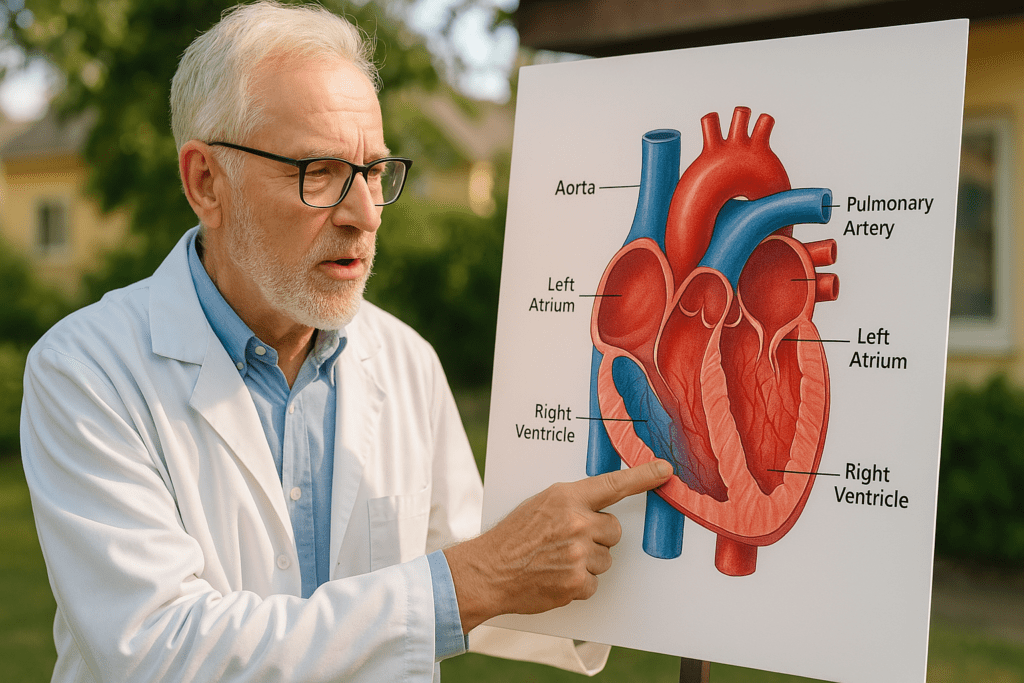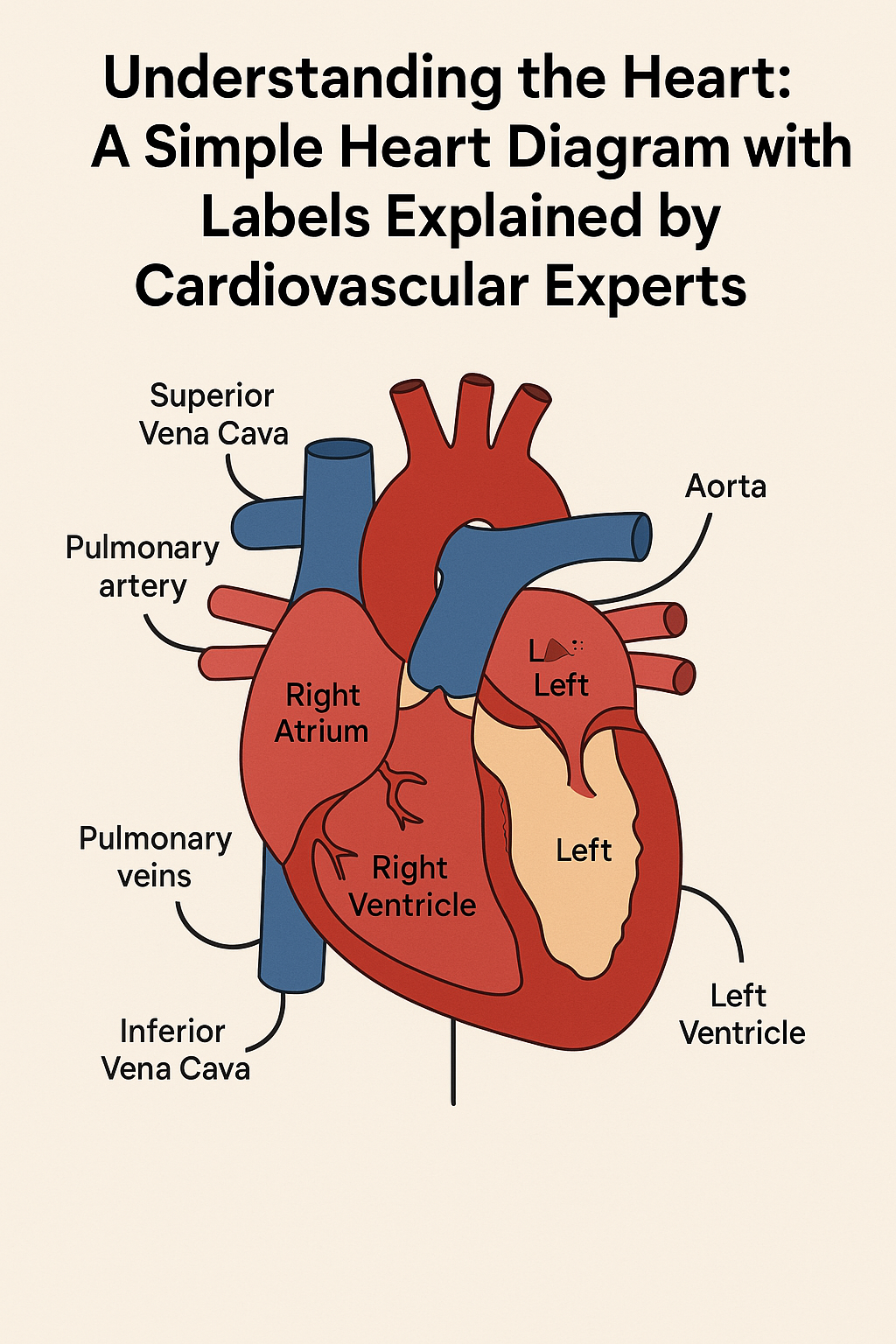Introduction: Why Understanding the Heart Matters
The human heart is more than just a symbol of love and emotion; it is a powerful organ that fuels life by ensuring oxygen and nutrient-rich blood circulates throughout the body. While many of us understand the general idea that the heart pumps blood, fewer are familiar with its precise structure and how each part works together. For patients, caregivers, and even students pursuing medical knowledge, a clear and simple heart diagram with labels can be a transformative educational tool. It helps demystify complex cardiovascular processes and fosters an informed appreciation for one of the body’s most vital organs. In this article, we will break down the intricacies of the human heart using a simple heart diagram and label each key component while explaining its function, supported by expert cardiovascular insights. Whether you’re a curious learner or someone managing a heart condition, this guide offers clarity and depth grounded in science and experience.
You may also like: 5 Ways to Keep Your Heart Healthy and Prevent Cardiovascular Disease
The Anatomical Structure of the Heart: A Functional Overview
At its core, the heart is a muscular organ divided into four main chambers—the left and right atria at the top, and the left and right ventricles at the bottom. These chambers coordinate in a rhythmic cycle of contraction and relaxation, which propels blood throughout the body. The atria serve as receiving chambers: the right atrium collects deoxygenated blood from the body, while the left atrium receives oxygenated blood from the lungs. From there, the ventricles take over, pumping blood either to the lungs (right ventricle) or to the rest of the body (left ventricle).
A simple heart diagram with labels often includes visual demarcations of these chambers, allowing viewers to follow the flow of blood step-by-step. Understanding this visual representation can significantly improve comprehension, particularly when discussing medical conditions like heart failure, arrhythmias, or valvular disease. Cardiovascular experts emphasize the importance of anatomical literacy, noting that even a basic grasp of how the heart is structured empowers patients to better engage with treatment decisions and preventive care.

Valves: The Gatekeepers of Cardiac Flow
One of the most important aspects of the heart’s anatomy involves its four main valves: the tricuspid, pulmonary, mitral, and aortic valves. These structures function like one-way gates, ensuring blood flows efficiently in the right direction without backtracking. The tricuspid valve sits between the right atrium and right ventricle, while the pulmonary valve controls flow from the right ventricle to the pulmonary artery. On the left side, the mitral valve separates the left atrium from the left ventricle, and the aortic valve regulates blood leaving the left ventricle into the aorta.
When using a heart diagram and label system to explain these valves, students and patients alike gain visual reinforcement of how these anatomical features interact with surrounding chambers. Cardiovascular specialists often point out that valve dysfunction—whether stenosis (narrowing) or regurgitation (leakage)—can lead to serious clinical outcomes. Informed by this understanding, individuals can appreciate why conditions such as mitral valve prolapse or aortic stenosis are closely monitored and, when needed, surgically corrected.
Circulatory Pathways: Pulmonary and Systemic Circuits
The heart functions as a dual pump, directing blood through two primary circuits: the pulmonary and systemic pathways. In the pulmonary circuit, deoxygenated blood is pumped from the right ventricle to the lungs, where it exchanges carbon dioxide for oxygen. The newly oxygenated blood then travels back to the left atrium via the pulmonary veins. From there, it enters the left ventricle and is pumped into the systemic circulation, delivering oxygen and nutrients to tissues throughout the body.
In a simple heart diagram with labels, arrows are often used to indicate the direction of blood flow within these two circuits. This visual aid supports a foundational understanding of why the right and left sides of the heart serve different yet equally essential roles. Cardiologists note that diseases affecting either pathway—such as pulmonary hypertension or systemic hypertension—can have profound and distinct clinical implications. Appreciating these circuits enhances one’s ability to interpret diagnostic tests like echocardiograms or MRIs that evaluate functional blood flow.
The Electrical System: Orchestrating the Heartbeat
While the heart is anatomically segmented, its function depends on a highly coordinated electrical system that initiates and synchronizes each heartbeat. This system begins with the sinoatrial (SA) node, often referred to as the heart’s natural pacemaker, located in the right atrium. It generates electrical impulses that spread across the atria, prompting them to contract. The impulse then travels to the atrioventricular (AV) node, where it pauses momentarily before descending through the bundle of His and Purkinje fibers to stimulate ventricular contraction.
When students are taught to label the heart, including elements of the electrical system in the diagram reinforces the integration between structure and function. For example, labeling the SA node, AV node, and conduction pathways visually links these components to their corresponding actions. Cardiologists emphasize that irregularities in this system—such as atrial fibrillation, bradycardia, or heart block—often stem from disruptions in electrical signaling, and they use labeled diagrams to explain these conditions to patients during consultations.
Coronary Arteries and the Heart’s Blood Supply
The heart, while pumping blood to every part of the body, also requires its own dedicated blood supply. This need is fulfilled by the coronary arteries, which branch off from the base of the aorta. The left coronary artery quickly bifurcates into the left anterior descending and circumflex arteries, while the right coronary artery courses around the right side of the heart. These vessels nourish the heart muscle (myocardium) with the oxygen and nutrients required for continuous function.
Including the coronary arteries in a simple heart diagram and label format allows learners to grasp how these vital vessels traverse the heart’s surface. This visualization is crucial when discussing conditions like coronary artery disease, in which plaque buildup restricts blood flow, potentially leading to angina or myocardial infarction (heart attack). Cardiovascular experts use these diagrams to explain the urgency of interventions such as angioplasty or coronary artery bypass grafting (CABG), especially when narrowing is seen in key arteries like the left anterior descending artery, colloquially known as the “widowmaker.”

Pericardium and Supporting Structures
Beyond its muscular walls and internal components, the heart is housed within a protective sac called the pericardium. This two-layered membrane contains a small amount of lubricating fluid, which reduces friction during each heartbeat. The pericardium plays an important role in anchoring the heart within the chest cavity and preventing excessive expansion when blood volume increases.
When illustrating the heart diagram and label sections, adding the pericardium helps learners appreciate that the heart does not operate in isolation. Supporting structures such as the great vessels—including the aorta, pulmonary arteries, and superior and inferior vena cava—should also be identified. These labeled features contextualize the heart within the broader cardiovascular system, facilitating a comprehensive understanding of how blood enters and exits the heart. Cardiovascular clinicians often highlight the significance of pericardial health when diagnosing conditions like pericarditis or cardiac tamponade, both of which involve inflammation or fluid accumulation within this protective sac.
Common Cardiovascular Conditions and Diagram-Based Learning
A labeled heart diagram serves not only as an anatomical reference but also as a diagnostic tool to explain common cardiovascular conditions. For example, when discussing congestive heart failure, a physician might point to the left ventricle on the diagram to explain how its impaired function leads to fluid buildup in the lungs. Similarly, in cases of atrial fibrillation, highlighting the atria can help patients understand where the electrical misfiring originates.
Using a simple heart diagram with labels enables a more interactive and visually grounded discussion of conditions such as myocardial infarction, valvular disease, cardiomyopathy, and congenital heart defects. This approach enhances health literacy by making complex ideas more accessible. It also supports shared decision-making, as patients who understand their diagnoses are more likely to engage meaningfully in their treatment plans. Cardiologists emphasize that informed patients are better equipped to recognize warning signs, adhere to medication regimens, and implement lifestyle changes to support heart health.
Educational Value in Medical and Public Health Contexts
In educational settings, particularly in anatomy, nursing, and medical school programs, the practice of labeling the heart is a foundational exercise. It bridges the gap between rote memorization and applied understanding. A labeled diagram encourages learners to move beyond isolated facts, helping them see how structures interact dynamically during each cardiac cycle.
Moreover, public health campaigns frequently rely on simplified and labeled heart diagrams to convey critical information to broader audiences. Whether explaining how hypertension damages the heart or demonstrating the effects of smoking on arterial walls, visual aids serve as powerful tools in behavior change strategies. Cardiovascular experts involved in health education stress that diagrams increase retention of key messages and foster better recall during emergencies or routine care.
Labeling the Heart: Tools for Improved Diagnosis and Patient Empowerment
When patients are shown a diagram and invited to label the heart alongside their physician, the resulting engagement can be profound. This practice transforms a passive interaction into an active dialogue. For instance, patients with stents can locate the affected arteries, while those with valve replacements can identify the exact site of intervention. Such contextual knowledge builds confidence and can reduce anxiety about complex treatments.
Labeling the heart also improves diagnostic communication. Physicians can better explain imaging results, such as echocardiograms or cardiac MRIs, when patients are already familiar with the structural layout. Cardiologists often report that patients who understand their anatomy are more likely to follow through with follow-up care and exhibit improved health outcomes. In this way, visual learning supports both emotional reassurance and clinical precision.
Bringing It All Together: A Holistic View of the Heart
While individual heart structures serve specific roles, the true beauty of the cardiovascular system lies in its interdependence. The seamless coordination between valves, chambers, blood vessels, and electrical signals illustrates a marvel of biological engineering. A simple heart diagram with labels not only breaks down these complex systems into manageable parts but also reveals how intricately they work together.
Cardiovascular experts advocate for using these diagrams as lifelong learning tools. They are not only beneficial in classrooms or clinical offices but also in personal health management. Whether tracking the progress of coronary artery disease or preparing for cardiac surgery, these labeled diagrams offer clarity amid complexity. They remind us that understanding the heart is not just an academic exercise—it is a foundation for lifelong wellness.

Frequently Asked Questions: Understanding the Heart Beyond the Diagram
What makes a simple heart diagram with labels such an effective learning tool for adults?
A simple heart diagram with labels offers a powerful visual anchor for adults who may be returning to biology or health science education after years away from formal schooling. Visual learners, in particular, benefit from seeing labeled structures rather than memorizing anatomy in abstract terms. These diagrams can also reduce cognitive load by distilling complex cardiovascular concepts into digestible parts, improving recall during medical consultations or emergency scenarios. When physicians or educators invite patients to label the heart themselves during appointments, the resulting engagement has been shown to increase compliance with cardiovascular treatments. For adults managing chronic conditions like hypertension or atrial fibrillation, a labeled diagram serves as a practical reference for understanding changes in their health over time.
How can using a heart diagram and label system improve communication between doctors and patients?
Using a heart diagram and label structure in clinical conversations enhances clarity and minimizes misinterpretations. When patients visually locate structures like the mitral valve or left ventricle, they are better equipped to understand how medical interventions—such as valve replacement or stent placement—impact those areas. This method reduces anxiety for many patients, especially those facing complex procedures, as it helps demystify medical jargon and fosters a shared language of understanding. Moreover, when reviewing imaging reports or surgical plans, being able to refer to a simple heart diagram makes these discussions more collaborative. Cardiologists note that patients who use labeled diagrams during their appointments often retain more information and express greater confidence in managing their health.
Are there psychological benefits to helping patients label the heart during diagnosis or treatment planning?
Yes, there is growing evidence that involving patients in labeling the heart can offer psychological benefits, particularly in reducing fear and enhancing perceived control. Facing a diagnosis like coronary artery disease can be overwhelming, but interacting with a simple heart diagram provides a sense of order and comprehension. The act of placing labels on a diagram gives patients a tactile way to process and internalize complex health information. This active involvement can reduce medical helplessness—a psychological phenomenon linked to poor treatment adherence. By encouraging patients to label the heart in a guided setting, providers not only foster education but also emotional resilience.
How are modern technologies enhancing traditional labeled heart diagrams?
Contemporary tools such as 3D visualization software and augmented reality (AR) are transforming how we engage with the traditional heart diagram and label format. Medical schools and hospitals increasingly utilize interactive models where users can rotate and dissect the heart in real time, revealing layers of anatomical complexity. These tools build on the strengths of a simple heart diagram by enabling dynamic exploration, which supports more advanced levels of understanding. Wearable AR devices are now being tested in cardiology clinics to help patients visualize how their own heart deviates from the healthy norm. These innovations do not replace the classic labeled diagram but rather extend its utility by bridging the gap between theory and personalized medicine.
Why is it important to regularly revisit and review a simple heart diagram, even for non-medical individuals?
Repetition strengthens retention, especially in health education. For non-medical individuals, regularly reviewing a simple heart diagram with labels can help reinforce key concepts related to blood flow, cardiac function, and warning signs of heart trouble. This is particularly relevant for caregivers, fitness professionals, or people with a family history of cardiovascular disease, as they may need to act quickly in an emergency. Additionally, many lifestyle changes—such as quitting smoking, exercising, or managing cholesterol—can be more meaningful when one understands their anatomical relevance. Revisiting labeled diagrams periodically refreshes awareness and keeps heart health top-of-mind.
Can children or teens benefit from using a simple heart diagram and label activity, and if so, how?
Absolutely. Although this article targets adults, introducing children and teens to cardiovascular concepts through a simple heart diagram and label exercise fosters lifelong health literacy. Early exposure to anatomy cultivates curiosity and lays the groundwork for more advanced science education later. Engaging younger learners in labeling the heart can also empower them to ask informed questions during pediatric checkups or sports physicals. With rising rates of childhood obesity and early-onset hypertension, building a basic understanding of heart health early on has never been more important. Plus, labeling the heart in a classroom setting encourages collaborative learning and spatial reasoning skills.
How can someone use a labeled heart diagram to track symptoms of potential heart problems?
While a heart diagram is not a diagnostic tool, it can function as a self-monitoring aid for individuals experiencing symptoms such as palpitations, chest tightness, or shortness of breath. For instance, by reviewing the areas on a labeled heart diagram associated with specific symptoms—like pressure over the left side of the chest—patients may become more attuned to patterns worth reporting. This increased awareness can enhance communication with physicians, particularly when describing vague or intermittent symptoms. Over time, using the diagram as a journal reference can help individuals document the progression or alleviation of symptoms based on lifestyle changes or medications. By visualizing how symptoms relate to different anatomical regions, patients become more proactive in their care.
What are some advanced clinical uses of a heart diagram and label format beyond basic education?
Beyond foundational learning, labeled heart diagrams play a vital role in advanced clinical environments, such as electrophysiology labs or cardiac catheterization suites. Here, diagrams are annotated in real time to mark arrhythmic foci or catheter entry points, serving as dynamic maps during procedures. In surgical settings, teams often rely on labeled diagrams to cross-reference with patient imaging, ensuring precision during valve repairs or bypass grafting. These clinical annotations go far beyond a simple heart diagram but evolve from the same principles—clear visualization and spatial orientation. Even in post-operative recovery, these diagrams help patients understand their surgical outcomes, especially when personalized with notes from their care team.
Is there a role for culturally adapted versions of the simple heart diagram in global health education?
Yes, cultural and linguistic context greatly influences how health information is received and understood. In global health initiatives, creating localized versions of the simple heart diagram with labels can bridge communication gaps and promote culturally sensitive education. For example, in areas where literacy rates are low, diagrams may use color-coding, pictograms, or translated labels to convey key concepts effectively. Tailoring diagrams to reflect local health beliefs or languages can also reduce resistance to modern medical explanations, especially in rural or traditional communities. Public health workers often report better engagement and understanding when they adapt visual tools like a labeled heart diagram to align with local norms and practices.
What innovations might shape the future of heart diagram and label tools in medicine and education?
The future of cardiovascular education is poised to integrate artificial intelligence (AI) with the heart diagram and label methodology. Imagine personalized diagrams generated from a patient’s cardiac MRI, with AI-generated insights overlaying key risk factors based on that individual’s health data. Virtual reality (VR) platforms are also being explored for immersive heart anatomy training, giving users the sensation of navigating through a beating heart. These advancements aim to elevate the simple heart diagram from a static tool to an interactive, data-driven resource. As these technologies mature, they will likely expand access to cardiology education across disciplines—from medical students to home caregivers—redefining what it means to label the heart in the digital age.
Conclusion: Empowering Cardiovascular Awareness Through a Labeled Heart Diagram
Understanding the heart through a clear, simple heart diagram and label system is more than just an academic endeavor—it is a gateway to health empowerment. By demystifying anatomy and grounding complex concepts in visual learning, these diagrams serve as essential tools for education, diagnosis, and patient engagement. They provide the scaffolding on which individuals can build a deeper understanding of their cardiovascular health, allowing them to make informed choices, ask better questions, and feel more confident in navigating medical conversations.
The ability to label the heart and comprehend each component’s function transforms passive awareness into active participation. Cardiovascular experts consistently emphasize that visual learning increases health literacy, supports early diagnosis, and improves outcomes across a wide range of conditions. In a world where heart disease remains the leading cause of death globally, promoting this type of understanding is both urgent and necessary.
As we continue to face rising rates of hypertension, obesity, and diabetes—all of which affect cardiovascular health—the value of foundational tools like a labeled heart diagram becomes even more apparent. Whether you’re a healthcare professional, a medical student, or simply someone invested in your well-being, taking the time to study and understand the heart’s structure is a meaningful step toward prevention, awareness, and longevity.
cardiac anatomy explained, human heart function, cardiovascular system basics, blood flow through the heart, heart health education, understanding heart valves, coronary artery anatomy, cardiac muscle structure, circulation system overview, educational heart diagram, cardiac conduction system, pericardial function, chambers of the heart, heart disease awareness, heart structure visualization, medical anatomy learning, atria and ventricles function, basic cardiovascular education, anatomy for patient education, clinical heart anatomy
Further Reading:
Structure and Function of the Heart
Your Heart & Circulatory System
Disclaimer
The information contained in this article is provided for general informational purposes only and is not intended to serve as medical, legal, or professional advice. While MedNewsPedia strives to present accurate, up-to-date, and reliable content, no warranty or guarantee, expressed or implied, is made regarding the completeness, accuracy, or adequacy of the information provided. Readers are strongly advised to seek the guidance of a qualified healthcare provider or other relevant professionals before acting on any information contained in this article. MedNewsPedia, its authors, editors, and contributors expressly disclaim any liability for any damages, losses, or consequences arising directly or indirectly from the use, interpretation, or reliance on any information presented herein. The views and opinions expressed in this article are those of the author(s) and do not necessarily reflect the official policies or positions of MedNewsPedia.


